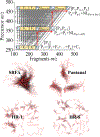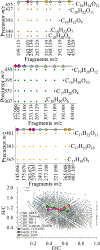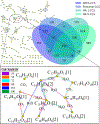Description of Dissolved Organic Matter Transformational Networks at the Molecular Level
- PMID: 36724500
- PMCID: PMC11834952
- DOI: 10.1021/acs.est.2c04715
Description of Dissolved Organic Matter Transformational Networks at the Molecular Level
Abstract
Dissolved Organic Matter (DOM) is an important component of the global carbon cycle. Unscrambling the structural footprint of DOM is key to understand its biogeochemical transformations at the mechanistic level. Although numerous studies have improved our knowledge of DOM chemical makeup, its three-dimensional picture remains largely unrevealed. In this work, we compare four solid phase extracted (SPE) DOM samples from three different freshwater ecosystems using high resolution mobility and ultrahigh-resolution Fourier transform ion cyclotron resonance tandem mass spectrometry (FT-ICR MS/MS). Structural families were identified based on neutral losses at the level of nominal mass using continuous accumulation of selected ions-collision induced dissociation (CASI-CID)FT-ICR MS/MS. Comparison of the structural families indicated dissimilarities in the structural footprint of this sample set. The structural family representation using Cytoscape software revealed characteristic clustering patterns among the DOM samples, thus confirming clear differences at the structural level (Only 10% is common across the four samples.). The analysis at the level of neutral loss-based functionalities suggests that hydration and carboxylation are ubiquitous transformational processes across the three ecosystems. In contrast, transformation mechanisms involving methoxy moieties may be constrained in estuarine systems due to extensive upstream lignin biodegradation. The inclusion of the isomeric content (mobility measurements at the level of chemical formula) in the structural family description suggests that additional transformation pathways and/or source variations are possible and account for the dissimilarities observed. While the structural character of more and diverse types of DOM samples needs to be assessed and added to this database, the results presented here demonstrate that Graph-DOM is a powerful tool capable of providing novel information on the DOM chemical footprint, based on structural interconnections of precursor molecules generated by fragmentation pathways and collisional cross sections.
Keywords: DOM; FT-ICR CASI-CID MS/MS; TIMS-FT-ICR MS; network; structural family.
Figures





References
-
- Chantigny MH Dissolved and water-extractable organic matter in soils: a review on the influence of land use and management practices. Geoderma 2003, 113 (3), 357–380.
-
- Tremblay L; Gagné J-P Organic matter distribution and reactivity in the waters of a large estuarine system. Marine Chemistry 2009, 116 (1), 1–12.
-
- Ridgwell A; Arndt S Chapter 1 - Why Dissolved Organics Matter: DOC in Ancient Oceans and Past Climate Change. In Biogeochemistry of Marine Dissolved Organic Matter (Second Edition), Hansell DA; Carlson CA, Eds.; Academic Press: Boston, 2015; pp 1–20.
-
- Moran MA; Kujawinski EB; Stubbins A; Fatland R; Aluwihare LI; Buchan A; Crump BC; Dorrestein PC; Dyhrman ST; Hess NJ; Howe B; Longnecker K; Medeiros PM; Niggemann J; Obernosterer I; Repeta DJ; Waldbauer JR Deciphering ocean carbon in a changing world. Proceedings of the National Academy of Sciences 2016, 113 (12), 3143–3151. - PMC - PubMed
-
- Lønborg C; Carreira C; Jickells T; Álvarez-Salgado XA Impacts of Global Change on Ocean Dissolved Organic Carbon (DOC) Cycling. Frontiers in Marine Science 2020, 7, 1–24. - PubMed
Publication types
MeSH terms
Substances
Grants and funding
LinkOut - more resources
Full Text Sources

